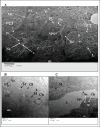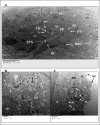Ecological and oral toxicity assessment of urea and camphor oil against Rattus norvegicus rats
- PMID: 38633158
- PMCID: PMC11018406
- DOI: 10.5455/OVJ.2024.v14.i1.45
Ecological and oral toxicity assessment of urea and camphor oil against Rattus norvegicus rats
Abstract
Background: One of the most challenging pests to control is the wild rat (Rattus norvegicus), which poses serious risks to both human health and the economy. Fertilizers are a more recent method of pest management with various action modes and are considered safe control agents when applied at low doses.
Aim: The present study aimed to examine the toxicological impacts of the contaminated water with urea and camphor oil individually, post-treatment of rats with camphor oil after the pre-treatment with urea and post-treatment of rats with urea mixed with camphor oil after urea pre-treatment against the wild rats (R. norvegicus).
Methods: The study extends to explore the influence of these treatments on the physicochemical parameters of the water administered by rats. Moreover, the effect of the most three toxic treatments was studied on the blood and renal functional parameters and the kidney tissue of rats after 21 days of treatment.
Results: The study showed that urea was more potent than camphor oil when applied individually and increasing the concentration of urea in the pre-treatment or when combined with camphor oil in the post-treatment caused a significant increase in the mortality of rats. The post-treatment of rats with camphor oil only or camphor oil mixed with urea after the pre-treatment with urea induced a synergistic activity against rats. In addition, the exposed water to urea and camphor oil has been modified in physicochemical parameters and formed ulcers and harm to the kidneys of the exposed wild rats.
Conclusion: This study significantly contributes to the ecological and toxicological potential risk indexes of urea and camphor oil together, which are restricted on the perceptible value relevance in the literature of water quality and renal pathology. Therefore, urea and camphor oil represent successful agents for the wild rat's control.
Keywords: Electron microscopy of rat kidney; Hematological parameters; Physicochemical parameters of water; Toxic influence; Urea and camphor oil.
Conflict of interest statement
The authors have no competing interests.
Figures



References
-
- Ambasht R.S, Ambasht P.K. Book. CBS Publishers & Distributors (4) Pvt. Ltd; 1990. Environment & Pollution: An Ecological Approach. ISBN 13: 9788123912233, pp: 323.
-
- ANZECC and ARMCANZ. Australian and New Zealand Guidelines for Fresh and Marine Water Quality. National Water Quality Management Strategy (NWQMS) 2000:314.
-
- Beshay R.M. 2005. Biological and toxicological studies on some rodents; p. 173. Ph.D. Thesis, Faculty of Agriculture, Benha University.
-
- Bignell C.M, Dunlope P.J. Volatile leaf oils of some South Western and Southern Australian species of the genus Eucalyptus. Part VII. Subgenus Symphyomyrtus section. Excert. Flav. Fragr. J. 1996;11:35–41.
MeSH terms
Substances
LinkOut - more resources
Full Text Sources
